Struggling with long wait times and inefficient call handling? 90% of customers expect instant service, and IVR systems are the key to meeting those demands. By automating interactions and streamlining call management, IVR enhances customer satisfaction while reducing agent workload.
In this blog, we break down everything you need to know—what IVR is, how it works, best practices, and the latest trends. Whether you want to improve efficiency or elevate customer experience, this guide will help you unlock the full potential of IVR technology.
Regularly monitor and analyze IVR call data to identify common pain points or areas for improvement. Use this feedback to fine-tune your IVR system, streamline customer interactions, and enhance overall efficiency and satisfaction.
What is IVR for the Contact Center?
IVR systems for contact centers are automated telephony solutions that engage callers, collect information, and direct incoming calls to the right agents or departments.
They utilize pre-recorded voice prompts and keypad inputs to navigate callers through menus, enhancing call efficiency, minimizing wait times, and promptly resolving common queries to boost customer satisfaction.
How Does an IVR for a Contact Center Work?
An IVR system interacts with callers through voice prompts and keypad inputs to gather information and direct calls to the appropriate department or self-service option. It uses pre-recorded messages and automated responses to efficiently manage and route customer inquiries.
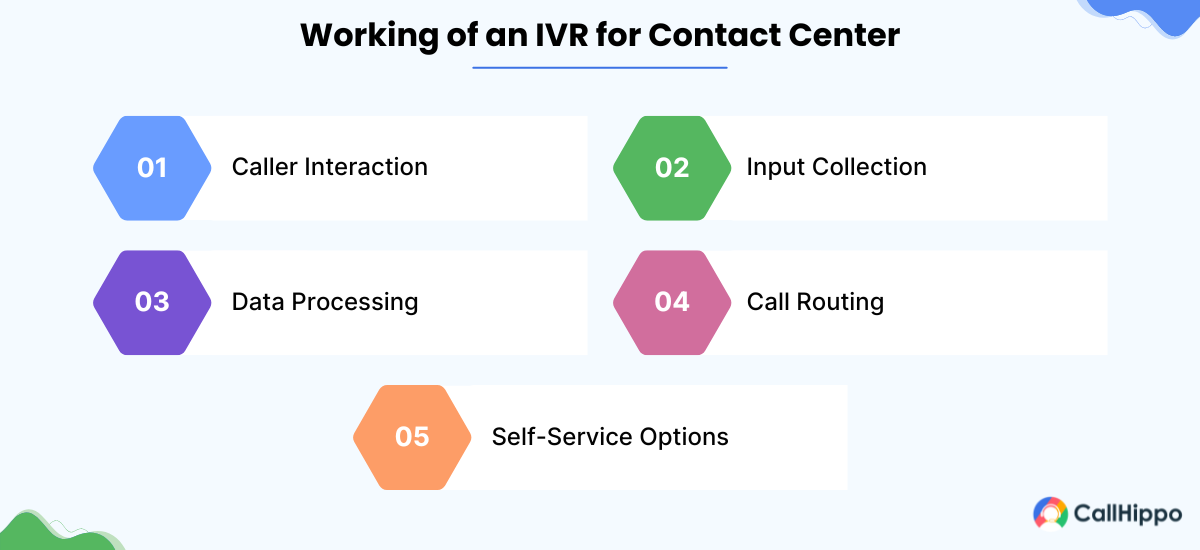
1. Caller Interaction
In an IVR contact center, the interaction begins when a high-value customer calls and is greeted by the system’s automated voice prompts.
The IVR guides the caller through a series of menu options designed to gather essential information and understand the purpose of the call. This initial interaction sets the stage for efficient call routing and ensures that the caller’s needs are addressed promptly and accurately.
2. Input Collection
During the input collection phase in an IVR system for call centers, the caller selects options from the menu using their phone’s keypad or voice commands. The IVR system processes these inputs to determine the caller’s specific needs.
This step is crucial for accurately routing the call or providing the necessary self-service options, ensuring a smooth and efficient customer experience.
3. Data Processing
In a contact center IVR solution, data processing involves interpreting the inputs received from the caller to understand their request or issue. The IVR system uses predefined algorithms and logic to match the caller’s inputs with the most appropriate responses or actions.
This could include accessing customer account details, checking service statuses, or identifying the best agent to handle the call. Efficient data processing ensures that the IVR system can provide accurate information and swift call resolution.
4. Call Routing
In a contact center IVR solution, call routing involves directing incoming calls to the appropriate agent or department based on the caller’s input to ensure efficient handling. Once the IVR system has processed the caller’s information, it uses routing algorithms to ensure the call reaches the right destination.
This step reduces wait times and ensures that callers are connected with agents who have the appropriate skills to address their needs, enhancing overall customer satisfaction and operational efficiency.
5. Self-Service Options
An IVR for contact centers offers self-service options, allowing callers to resolve common issues without human assistance.
These customer service automated services can handle tasks like checking account balances, updating personal information, making payments, or getting answers to frequently asked questions.
By providing efficient self-service options, the IVR system reduces the volume of calls that require agent intervention, thereby decreasing wait times and improving the overall customer experience while freeing up contact center agents to handle more complex inquiries.
in Less Than 3 Minutes
- Create IVR Menus
- Customize Greetings
- Improve Customer Experience

IVR Contact Center Best Practices
Implementing best practices for an IVR contact center ensures optimal functionality, enhances customer satisfaction, and maximizes the efficiency of call-handling processes.
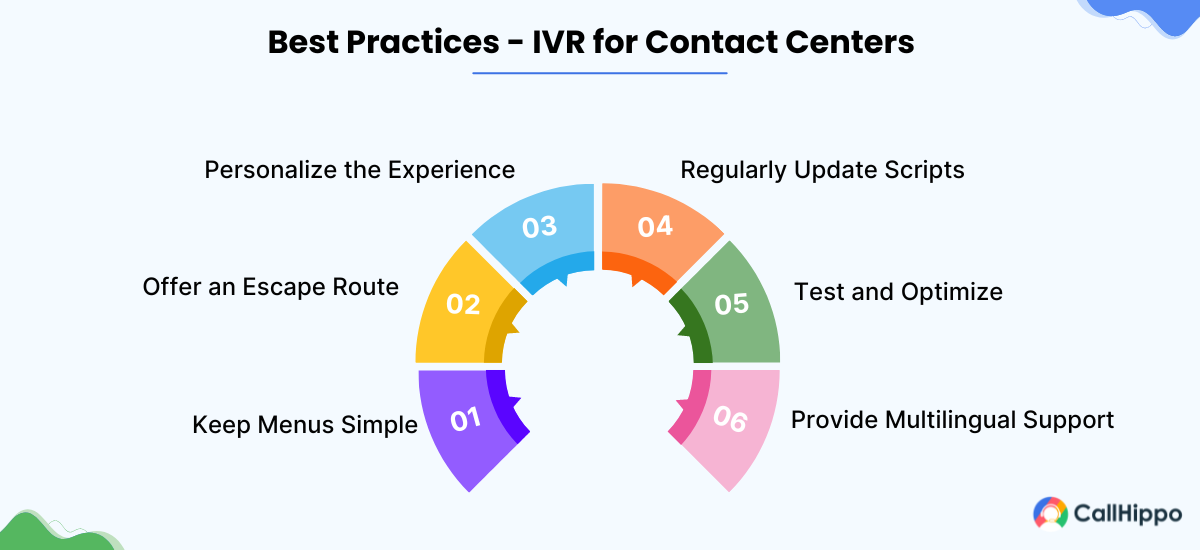
Here are some of the best practices for IVR contact center operations
1. Simplify Menu Structures
Design your IVR menus to be intuitive and user-friendly. Limit the number of options to prevent overwhelming callers, and ensure each choice is clearly defined. A well-organized menu helps customers quickly find the information or assistance they need, reducing frustration and call times.
Actionable Tip: Map out your call flow to create a logical progression of options, placing the most commonly requested services at the beginning of the menu.
2. Provide an Option to Speak to a Live Agent
Always offer callers the choice to connect with a human representative. While automation handles routine inquiries efficiently, some issues require personal attention. An easy-to-access “escape route” ensures that customers can quickly reach an agent when needed, enhancing satisfaction and trust.
Actionable Tip: Include a prompt in your menu that allows callers to press a specific key or say a command to be transferred to a live agent.
3. Personalize Caller Interactions
Utilize caller ID and historical interaction data to tailor the IVR experience. Recognizing returning customers and anticipating their needs can make interactions more efficient and pleasant. Personalization fosters a sense of value and strengthens customer relationships.
Actionable Tip:Greet callers by name and offer menu options based on their previous interactions or preferences.
4. Regularly Update IVR Scripts
Keep your IVR prompts current to reflect changes in services, products, or business information. Regular reviews and updates ensure that customers receive accurate and relevant information, maintaining the system’s effectiveness and professionalism.
Actionable Tip: Schedule periodic audits of your IVR scripts to incorporate new services or address common customer inquiries.
5. Conduct Regular Testing and Optimization
Regularly test your IVR system to identify and resolve issues in call routing, menu navigation, and voice recognition. Analyze call data and customer feedback to make informed adjustments that enhance user experience and operational efficiency.
Actionable Tip: Implement usability testing sessions and gather analytics to identify bottlenecks or points of confusion within the IVR system.
6. Offer Multilingual Support
Cater to a diverse customer base by providing IVR menu options in multiple languages. This inclusivity ensures that non-native speakers can navigate the system comfortably, improving communication and reducing misunderstandings.
Actionable Tip: Analyze your customer demographics to determine which languages are most prevalent and prioritize support for those languages in your IVR system.
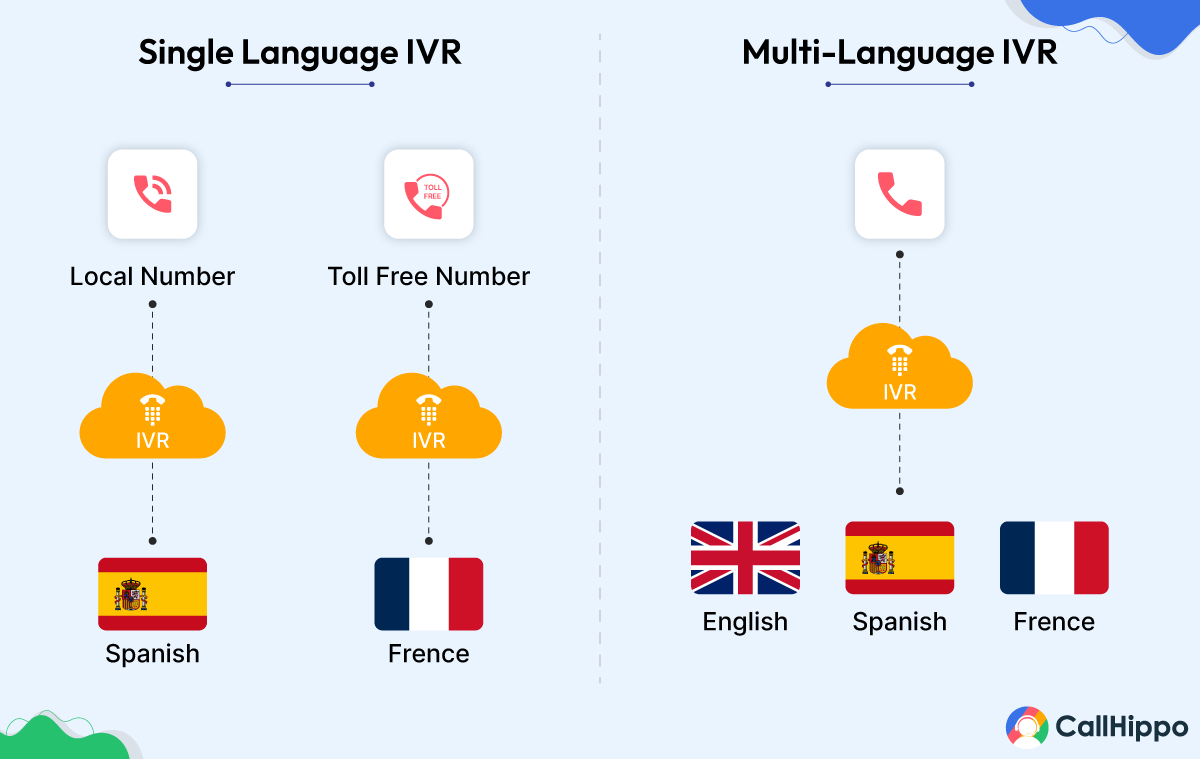
Multilingual support demonstrates inclusivity and responsiveness to cultural diversity, fostering a positive customer experience and strengthening relationships with a broader customer base.
Benefits of IVR Contact Center
Understanding the advantages of implementing an IVR system in a contact center enhances operational efficiency and customer satisfaction.
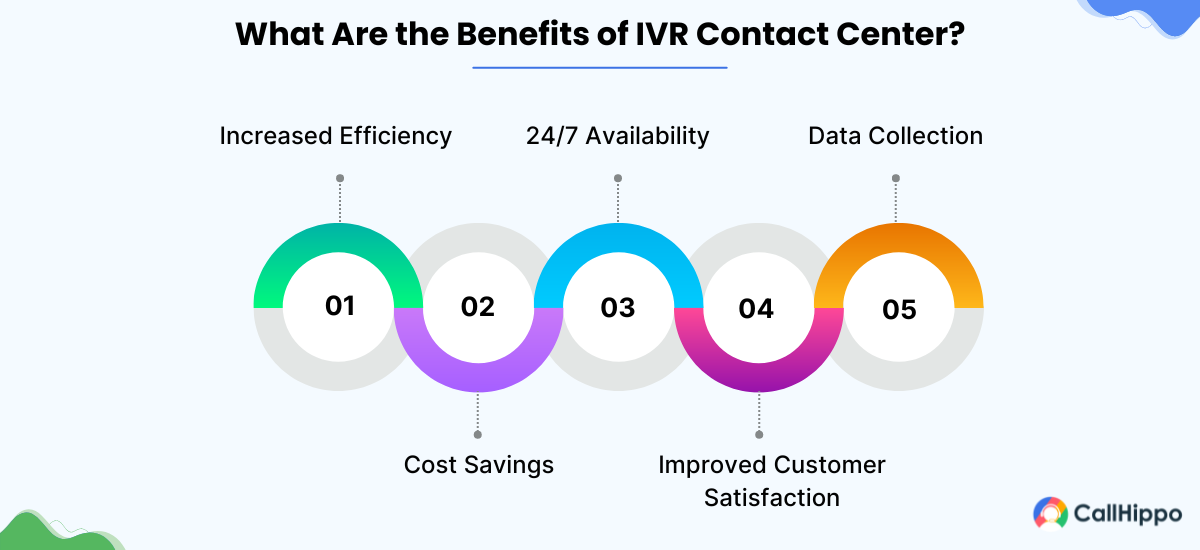
Below are some of the key benefits of IVR contact center software
1. Increased Efficiency
IVR systems streamline call handling by automating routine tasks such as call routing and information retrieval. This automation reduces the workload on human agents, allowing them to focus on more complex customer issues. Efficient call routing minimizes wait times and optimizes operations, leading to improved service delivery.
For instance, Telefónica have reported that IVR systems provides real-time answers and increase agent productivity.
2. Cost Savings
By automating routine inquiries, IVR systems reduce the need for a large customer service team, leading to significant savings in staffing and operational expenses. This cost-effectiveness allows businesses to maintain high service quality while optimizing resource utilization.
A case study highlighted that implementing an IVR system helped a high-tech services company reduce customer support costs while maintaining customer satisfaction. Read full case study here.
3. 24/7 Availability
An IVR system in call centers guarantees 24/7 availability, enabling customers to access information and services anytime. By automating basic inquiries and call routing, businesses can maintain continuous service without relying solely on human agents.
This capability improves customer satisfaction by providing instant assistance outside regular business hours, enhancing accessibility and responsiveness to customer needs around the clock.
4. Improved Customer Satisfaction
Implementing an IVR menu system in a call center improves customer satisfaction by providing quicker access to information and services through streamlined call routing and automated responses.
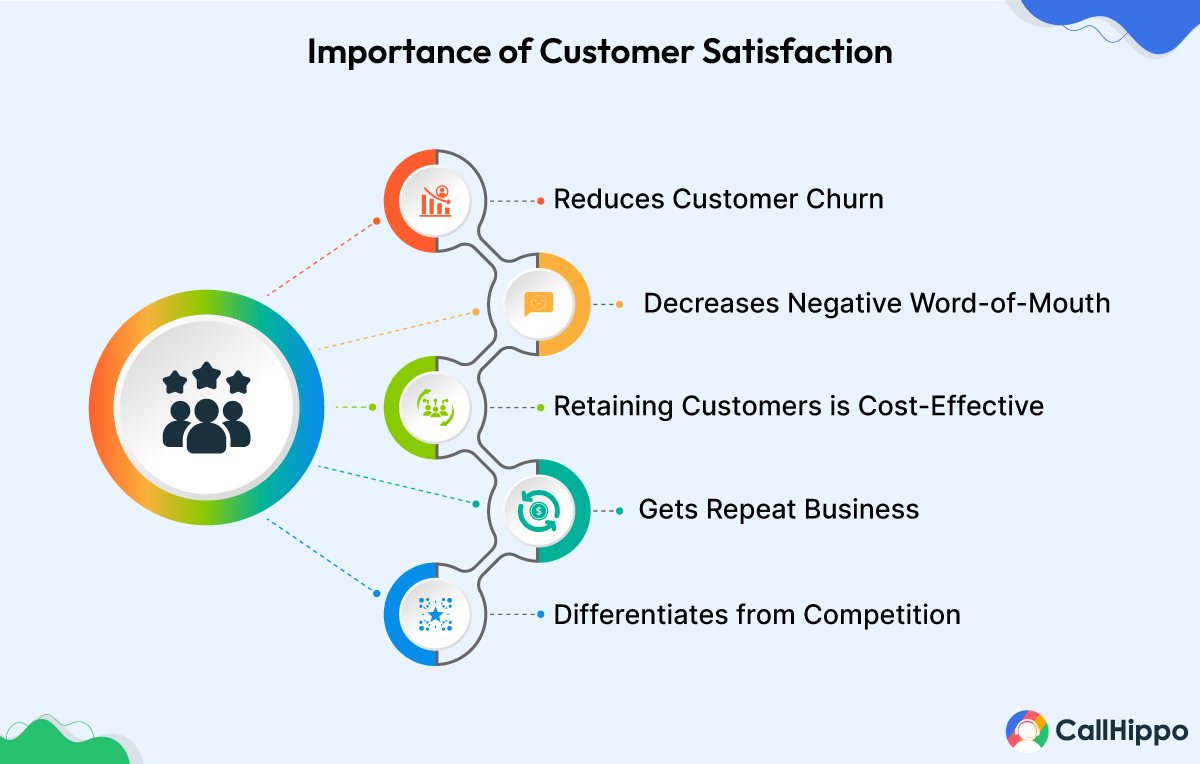
This reduces wait times, ensures consistent service delivery, and allows customers to resolve issues efficiently. By providing an intuitive and responsive IVR experience, businesses can improve overall customer satisfaction and loyalty.
5. Data Collection
An IVR system in a contact center facilitates data collection by gathering valuable insights from customer interactions. This data includes caller preferences, frequently asked questions, and interaction patterns, which can be analyzed to improve service delivery and customer engagement strategies.
By using this data, businesses can make informed decisions, tailor customer interactions, and boost operational efficiency, leading to business growth and enhancing the overall customer experience.
Trends in Contact Center IVR Technologies
Explore the evolving landscape of IVR systems in contact centers, focusing on advancements that enhance customer interactions, operational efficiency, and overall service delivery.
1. Integration with AI and Machine Learning
IVR systems are leveraging AI and machine learning algorithms to analyze caller intent, predict customer needs, and offer personalized responses, thereby improving efficiency and customer satisfaction.
2. Natural Language Processing (NLP)
Advanced Natural Language Processing (NLP) capabilities empower IVR systems to comprehend and respond to natural language inputs, facilitating intuitive and conversational interactions with callers.
3. Cloud-Based Solutions
Cloud-based IVR solutions provide scalability and flexibility, allowing contact centers to easily adjust capacity based on demand and integrate with other cloud communications services for enhanced functionality and cost savings.
4. Omnichannel Support
Modern IVR technologies support omnichannel communication, enabling seamless transitions between channels like voice calls, chatbots, and social media platforms, ensuring a consistent customer experience across all touchpoints.
5. Speech Recognition Advancements
Improvements in speech recognition technology enhance IVR usability by accurately interpreting spoken commands and reducing reliance on keypad inputs, making interactions more natural and efficient for callers.
These trends reflect ongoing advancements aimed at enhancing efficiency, personalization, and overall customer satisfaction in contact center IVR technologies.
Conclusion
Implementing an effective IVR system can significantly enhance your contact center’s efficiency and customer satisfaction. By keeping menus simple, offering personalized experiences, and utilizing the latest technologies, businesses can create a seamless and efficient customer service experience.
As IVR technology continues to evolve, staying updated with the latest trends and best practices will ensure your contact center remains competitive and responsive to customer needs.
FAQs
1. What is a care call IVR system?
A care call IVR system is an automated service that manages follow-up calls to ensure customer satisfaction and address any post-interaction issues.
2. How to make an IVR call?
To make an IVR call, dial the customer service number, listen to the menu options, and use your phone’s keypad or voice commands to navigate through the system.
3. How many types of IVR are there?
There are two main types of IVR software: inbound IVR, which handles incoming calls, and outbound IVR, which automates outgoing calls for surveys, reminders, or notifications.
4. What are examples of IVR?
Examples of call center IVR systems include automated bank account balance inquiries, airline flight status updates, and appointment scheduling systems.

Subscribe to our newsletter & never miss our latest news and promotions.









